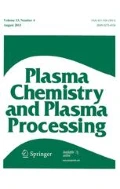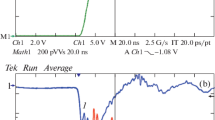Abstract
Atmospheric pressure mass spectrometry (APCI-MS) was used to investigate the positive ions in air containing acetone (A), methanol (M) and mixtures thereof (A + M), subjected to +dc corona discharges. The results of experiments with isotopically labelled analogues, perdeuterated acetone Adeu and methanol Mdeu, and relevant thermochemical data found in the literature allowed us to identify the main ionic reactions occurring in single component systems (A or M) and in binary mixtures (A + M). It is concluded that, thanks to its significantly higher proton affinity, A is very efficient in quenching M-derived ions at atmospheric pressure. These conclusions provide a rationale for interpreting the results of a parallel investigation on the reciprocal effects of M and A when treated together in air at atmospheric pressure with +dc corona in a non-thermal plasma reactor developed previously in our laboratory. Specifically, we observed a marked drop in the degradation efficiency of methanol when it was treated in the presence of an equivalent amount of acetone. This effect is attributed to acetone interfering with ion-initiated degradation processes of methanol, and supports the conclusion that ions and ionic reactions are important in dc+ corona induced oxidation of volatile organic pollutants in air.







Similar content being viewed by others

References
Kim HH (2004) Nonthermal plasma processing for air-pollution control: a historical review, current issues, and future prospects. Plasma Process Polym 1:91–110
Fridman A (2008) Plasma chemistry. Cambridge University Press, Cambridge
Schiavon M, Torretta V, Casazza A, Ragazzi M (2017) Non-thermal plasma as an innovative option for the abatement of volatile organic compounds: a review. Water Air Soil Pollut 228:388
Xiao G, Xu W, Wu R, Ni M, Du C, Gao X, Luo Z, Cen K (2014) Non-thermal plasmas for VOCs abatement. Plasma Chem Plasma Process 34:1033–1065
Vandenbroucke AM, Morent R, De Geyter N, Leys C (2011) Non-thermal plasmas for non-catalytic and catalytic VOC abatement. J Hazard Mater 195:30–54
Zhang Z, Jiang Z, Shangguan W (2016) Low-temperature catalysis for VOCs removal in technology and application: a state-of-the-art review. Catal Today 26:270–278
Yao X, Jiang N, Li J, Lu N, Shang K, Wu Y (2019) An improved corona discharge ignited by oxide cathodes with high secondary electron emission for toluene degradation. Chem Eng J 362:339–348
Kim HH, Teramoto Y, Ogata A (2019) Plasma-catalyst interactions. In: Tu X, Whitehead J, Nozaki T (eds) Plasma catalysis, vol 106. Springer Series on Atomic, Optical, and Plasma Physics. Springer, Cham
Du C, Gong X, Lin Y (2019) Decomposition of volatile organic compounds using corona discharge plasma technology. J Air Waste Manag Assoc 69:879–899
Penetrante BM, Hsiao MC, Bardsley JN, Merritt BT, Vogtlin GE, Wallmann PH (1996) Electron beam and pulsed corona processing of volatile organic compounds in gas streams. Pure Appl Chem 68:1083–1087
Krasnoperov LN, Krishtopa LG, Bozzelli JW (1997) Study of volatile organic compounds destruction by dielectric barrier corona discharge. J Adv Oxid Technol 2:248–256
Sieck LW, Buckley TJ, Herron JT, Green DS (2001) Pulsed electron.beam ionization of humid air and humid air/toluene mixtures: time-resolved cationic kinetics and comparison with predictive models. Plasma Chem Plasma Process 21:441–457
Rudolph R, Francke KP, Miessner H (2002) Concentration dependence of VOC decomposition by dielectric barrier discharges. Plasma Chem Plasma Process 22:401–412
Marotta E, Scorrano G, Paradisi C (2005) Ionic reactions of chlorinated VOCs in air plasma at atmospheric pressure. Plasma Process Polym 2:209–217
Marotta E, Callea A, Ren X, Rea M, Paradisi C (2007) DC corona electric discharges for air pollution control. Part 2. Ionic intermediates and mechanisms of hydrocarbon processing. Plasma Process Polym 5:146–154
Marotta E, Schiorlin M, Rea M, Paradisi C (2010) Products and mechanisms of the oxidation of organic compounds in atmospheric air plasmas. J Phys D Appl Phys 43:124011
Schiorlin M, Marotta Dal Molin M, Paradisi C (2013) Oxidation mechanisms of CF2Br2 and CH2Br2 induced by air nonthermal plasma. Environ Sci Technol 47:542–548
Perillo R, Ferracin E, Giardina A, Marotta E, Paradisi C (2019) Efficiency, products and mechanisms of ethyl acetate oxidative degradation in air non-thermal plasma. J Phys D Appl Phys 52:295206
Marotta E, Paradisi C (2009) A mass spectrometry study of alkanes in air plasma at atmospheric pressure. J Am Mass Spectrom Soc 20:697–707
Schiorlin M, Marotta E, Rea M, Paradisi C (2009) Comparison of toluene removal in air at atmospheric conditions by different corona discharges. Environ Sci Technol 24:9386–9392
Marotta E, Paradisi C, Scorrano G (2004) An atmospheric pressure chemical ionization study of the positive and negative ion chemistry of the hydrofluorocarbons 1,1-difluoroethane (HFC-152a) and 1,1,1,2-tetrafluoroethane (HFC-134a) and of perfluoro-n-hexane (FC-72) in air plasma at atmospheric pressure. J Mass Spectrom 39:791–801
Marotta E, Bosa E, Scorrano G, Paradisi C (2005) Positive and negative ion chemistry of the anesthetic halothane (1-bromo-1-chloro-2,2,2-trifluoroethane) in air plasma at atmospheric pressure. Rapid Commun Mass Spectrom 19:391–396
Marotta E, Cooks RG, Paradisi C (2005) Novel CFCs-substitutes recommended by EPA (hydrofluorocarbon-245fa and hydrofluoroether 7100): ion chemistry in air plasma and reactions with atmospheric ions. E. Marotta, R. G., C. Paradisi. J Am Mass Spectrom Soc 16:1081–1092
Marotta E, Paradisi C (2005) Positive ion chemistry of esters of carboxylic acids in air plasma at atmospheric pressure. J Mass Spectrom 40:1583–1589
Sobacchi MG, Saveliev AV, Fridman AA, Gutsol AF, Kennedy LA (2003) Experimental assessment of pulsed corona discharge for treatment of VOCs emissions. Plasma Chem Plasma Process 23:347–370
Hester RE, Harrison RM, Atkinson R (1995) Gas phase tropospheric chemistry of organic compounds. In: Harrison RM, Hester RE (eds) Volatile organic compounds in the atmosphere, Series: Issues in Environmental Science and Technology. The Royal Society of Chemistry
Penetrante BM, Hsiao MC, Bardsley JN, Merritt BT, Vogtlin GE, Kuthi A, Burkhart CP, Bayless JR (1997) Identification of mechanisms for decomposition of air pollutants by non-thermal plasma processing. Plasma Sources Sci Technol 6:251–259
Norsic C, Tatibouët JM, Batiot-Dupeyrat C, Fourré E (2018) Methanol oxidation in dry and humid air by dielectric barrier discharge plasma combined with MnO2–CuO based catalysts. Chem Eng J 347:944–952
Pasquiers S, Blin-Simiand N, Magne L (2016) Dissociation against oxidation kinetics for the conversion of VOCs in non-thermal plasmas of atmospheric gases. EPJ Appl Phys 75:150575
Rohani V, Affonso Nobrega PP, Zadeh M, Cauneau F, Fulcheri L (2017) Combination of VOC degradation and electro-hydrodynamic pumping actions in a surface dielectric barrier discharge reactor. Chem Eng J 309:471–479
Li X, Guo T, Peng Z, Xu L, Dong J, Cheng P, Zhou Z (2019) Real-time monitoring and quantification of organic by-products and mechanism study of acetone decomposition in a dielectric barrier discharge reactor. Environ Sci Pollut Res 26:6773–6781
Chang CL, Lin TS (2005) Decomposition of toluene and acetone in packed dielectric barrier discharge reactors. Plasma Chem Plasma Process 25:227–243
Hou L, Li X, Xie D, Wang H (2018) Effects of BTEX on the removal of acetone in a coaxial non-thermal plasma reactor: role analysis of the methyl group. Molecules 23:890
Derakhshesh M, Abedi J, Hassanzadeh H (2010) Mechanism of methanol decomposition by non-thermal plasma. J Electrostat 68:424–428
Marotta E, Callea A, Rea M, Paradisi C (2007) DC corona electric discharges for air pollution control. Part 1. Efficiency and products of hydrocarbon processing. Environ Sci Technol 41:5862–5868
Donò A, Paradisi C, Scorrano G (1997) Abatement of volatile organic compounds by corona discharge. a study of the reactivity of trichloroethylene under atmospheric conditions. Rapid Commun Mass Spectrom 11:1687–1694
Slater C, Douglas-Hamilton DH (1981) Electron beam initiated destruction of low concentration of vinyl chloride in carrier gases. J Appl Phys 9:5820–5828
Zhao X, Liu X, Liu J, Chen J, Fu S, Zhong F (2019) The effect of ionization energy and hydrogen weight fraction on the non-thermal plasma volatile organic compounds removal efficiency. J Phys D Appl Phys 52:145201
Lias SG (2004) Ionization energy evaluation. In: Maillard WG, Linstrom PJ (eds) NIST chemistry webbook, NIST Standard Reference Database No. 69. National Institute of Standards and Technology, Gaithersburg MD. http://webbook.nist.gov/chemistry/
Mair C, Fiegele T, Biasioli F, Herman Z, Märk TD (1999) Surface-induced reactions of acetone cluster ions. J Chem Phys 111:2770–2778
Acknowledgements
The authors thank GioloCenter for financial support to their research on VOC decomposition by application of non-thermal plasma.
Author information
Authors and Affiliations
Corresponding author
Additional information
Publisher's Note
Springer Nature remains neutral with regard to jurisdictional claims in published maps and institutional affiliations.
Rights and permissions
About this article
Cite this article
Giardina, A., Schiorlin, M., Marotta, E. et al. Atmospheric Pressure Non-thermal Plasma for Air Purification: Ions and Ionic Reactions Induced by dc+ Corona Discharges in Air Contaminated with Acetone and Methanol. Plasma Chem Plasma Process 40, 1091–1107 (2020). https://doi.org/10.1007/s11090-020-10087-x
Received:
Accepted:
Published:
Issue Date:
DOI: https://doi.org/10.1007/s11090-020-10087-x


